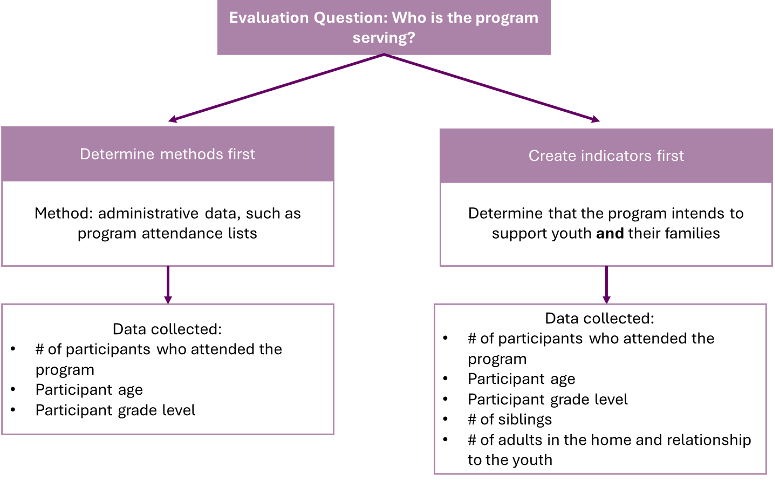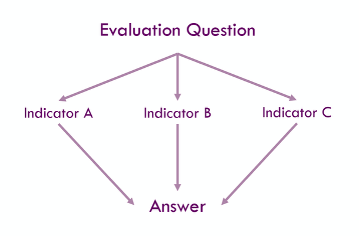Bridging The Gap: From Evaluation Questions To Indicators
November 2025
This article is rated as:
Here at Eval Academy, we’ve written a fair amount about writing evaluation questions, but what happens after you’ve created the questions? I’ve found the process of moving from evaluation questions to indicators, then methods or measures, to be tricky. Often, I find that once the evaluation questions are finalized, clients want to jump straight into talking about evaluation methods and measures. They want to know what survey questions we will ask to gather evidence, or they want to dig into the administrative data to develop insights.
Indicators sit in an in-between space. Developing indicators is an important intermediate step between evaluation questions and methods (the evaluation tools we will use to collect the data) and the measures (developing the specific evaluation tools). Indicators guide the methods and measures you use to ensure you are collecting the right information to answer your evaluation question. Sure, you could skip indicator development, but you may find that once you’ve collected your data, you’ve missed an important piece of information that is necessary to answer your evaluation question.
For example, an after-school program supporting youth to manage their emotions, wants to answer the evaluation question “who is the program serving?” Developing the indicators first provides a space to clearly define who the program is meant to serve and what information about them is important to collect. Without narrowing down indicators and moving right to determining methods, we may miss careful considerations such as defining who the program is intended to serve and making sure we collect data about them.
In this example, the program might have intended impacts not just on the youth, but also on their immediate families as the youth learn to manage their emotions and model their learnings with those around them.
What makes a good indicator
A good set of indicators tells you what information you need to gather to answer your evaluation questions and helps to determine the specific methods and measures you will use to collect the data. Indicators can come from different sources to answer the same evaluation question. In fact, it is often stronger to include indicators from a variety of sources to support triangulation.
Indicators narrow down what about the evaluation questions are feasible, measurable, and important to collect. They tell us which aspects of the evaluation question we should focus on.
Indicators should be:
Specific (descriptive)
Observable (focus on an action or a change)
Measurable (quantifiable or able to be described)
Timely (relative to your evaluation timeframe)
Feasible (realistic within the limits of the evaluation)
Aligned with the evaluation questions (address an aspect of the evaluation question)
How to select indicators
Selecting indicators is a bit of a delicate dance. Although I just told you to avoid jumping straight into methods, methodological considerations often influence indicator choice and cannot be ignored throughout the process of selecting indicators. While I present how to select indicators as a series of steps, the process is definitely not linear. An evaluator must balance what data already exist, what data are needed, and what is feasible to collect.
Identify the key concepts and variables that are important to know for each evaluation question
Identify what measures already exist and develop indicators for the pieces of data which will help support your evaluation (Note: this means that although some data collection methods already exist, you do not have to include all of the measures they are tracking. For example, administrative data may collect more information than you need. Creating specific indicators based on the data that are collected help you to know which data points to include in your analysis. This also helps maintain your evaluation scope. Using our data request template can help you collect this information during project on boarding). Consider whether validated tools may support the evaluation and provide indicators.
Check for alignment with clients or intended evaluation users. Tools such as priority-feasibility matrices can help with decision making.
Select your methods and refine indicators for clarity, relevance, and measurability.
Indicator types
Indicators can be quantitative or qualitative. Quantitative indicators often include # or % and answer questions such as “how many”, “how often”, “for whom”. Qualitative indicators provide contextual information and are descriptive in nature. Qualitative indicators answer questions such as “why” or “how” or asking people about their perceptions and experiences.
Others have further categorized indicators into different types. Inspiring Communities defines six categories of indicators:
Participation (who)
Progress (what happened)
Performance (how/how well)
Possibility (can do/do next)
Population or people indicators (what’s changed)
Policy/systems change indicators (what’s being done differently now)
Similarly, What Works in New Zealand defines six categories of indicators:
Participation (who, how many)
Process (what happened, how many involved)
Results (did you do what you expected)
Outputs (things the program changed)
Outcome (what changes your program caused in medium to long term)
Impact (long term effect)
You can use these categories to help you think through the variety of indicator types that you might use to collect data.
Final Tips
Writing indicators is a balance between answering your evaluation questions and managing your evaluation methods. A few final tips for you to consider as you write indicators for your next evaluation:
Ensure a balance of quantitative and qualitative to understand the story behind the data. Our article on mixed methods can help you here.
Make sure indicators are driven by purpose- consider whether and how they add value to the evaluation. A smaller, more curated list of indicators that are relevant is more useful than a long list of semi-relevant indicators.
Involve those in collecting and using the data to create more curated indicators; design the indicators with their end use in mind.
Use your logic model or theory of change to help you develop outcome, output, progress/process, and impact indicators.
Developing effective evaluation indicators requires thoughtful consideration of both the questions you wish to answer and the practicalities of your data collection methods. Striking the right balance between qualitative and quantitative approaches ensures your findings are both meaningful and actionable.
By prioritizing purpose-driven, relevant, and feasible indicators, you can create a robust framework that supports clear, informed decision-making. Ultimately, thoughtful indicator selection is key to ensuring your evaluation is measuring what you want it to measure.






